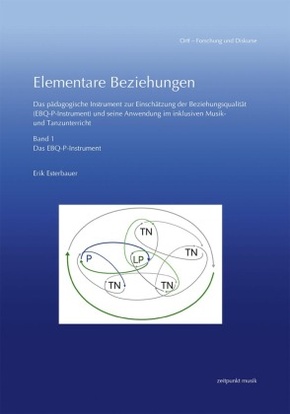Paket Elementare Beziehungen - Das pädagogische Instrument zur Einschätzung der Beziehungsqualität (EBQ-P-Instrument) und seine Anwendung im inklusiven Musik- und Tanzunterricht Band 1: Das EBQ-P-Instrument Praxis: Grundlagen, Merkma
| Verlag | Reichert |
| Auflage | 2024 |
| Seiten | 255 |
| Format | 17,0 x 3,0 x 24,0 cm |
| 2 Bde: Band 1: 216 Seiten, 16 sw-Abbildungen, 18 Farbabbildungen Band 2: 306 Seiten, 33 sw-Abbildungen, 9 Farbabbildung. | |
| Gewicht | 879 g |
| Reihe | zeitpunkt musik |
| ISBN-10 | 3752008768 |
| ISBN-13 | 9783752008760 |
| Bestell-Nr | 75200876A |
In music education communicative and relationship-oriented skills, in addition to individual musical and movement-related possibilities, play a key role in the design of artistic-educational teaching and learning processes. The AQR-P Tool presented here can contribute to the improvement of teachers' actions on the basis of relationship skills with the aim of providing the best possible support to each person involved through lesson planning.
In elemental music and dance education and other music education subjects, in addition to individual musical and movement-related possibilities, communicative and relationship-oriented skills play a key role in the design of artistic-pedagogical teaching-learning processes. A precise assessment of the ability and quality of relationship and the subsequent reflection on the teaching situation, which is made possible by the "AQR-P Tool" observation and assessment procedure presented here, can support an adequate adaptation of the teacher's actions to the needs of the learners.
By knowing the currently existing relationship mode and the "pedagogical relationship quality" to be adapted to it, the teacher can design tasks and activities in such a way that the learners can make optimal use of these activities.
Volume 1 explains the theoretical foundations upon which the AQR-P Tool was developed and adapted and presents the observation procedure in its entirety so that it can be used directly in practice. In addition, the application possibilities and further development variants are shown.
Volume 2 offers extended materials on the areas of inclusion and inclusive didactics with a focus on elemental music and dance education as well as the importance of the topic of relationships in educational contexts. The research process is then presented in detail and the research questions answered on the basis of the results. A summary and comparison of the existing variants of the AQR Tool concludes the research-relevant section.

